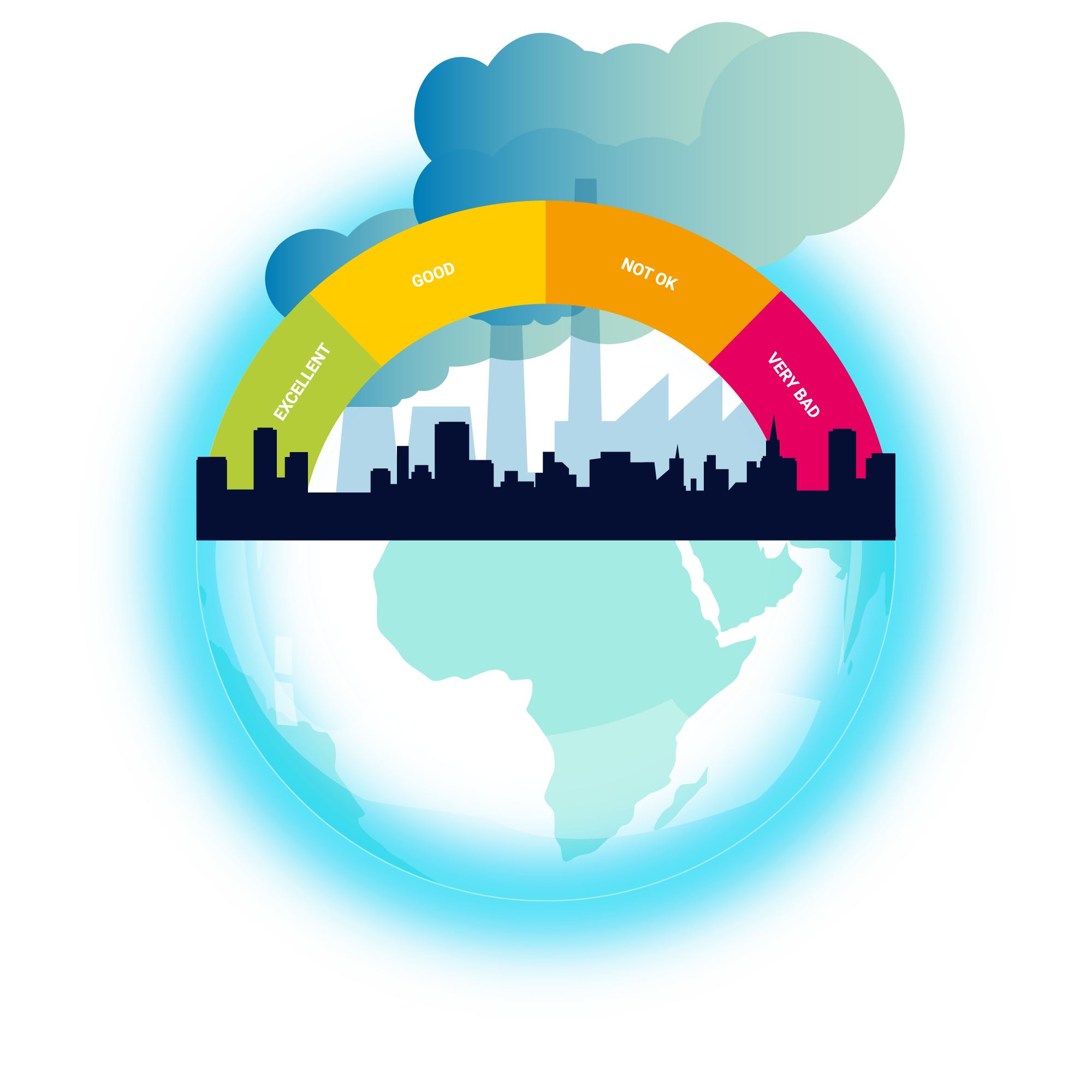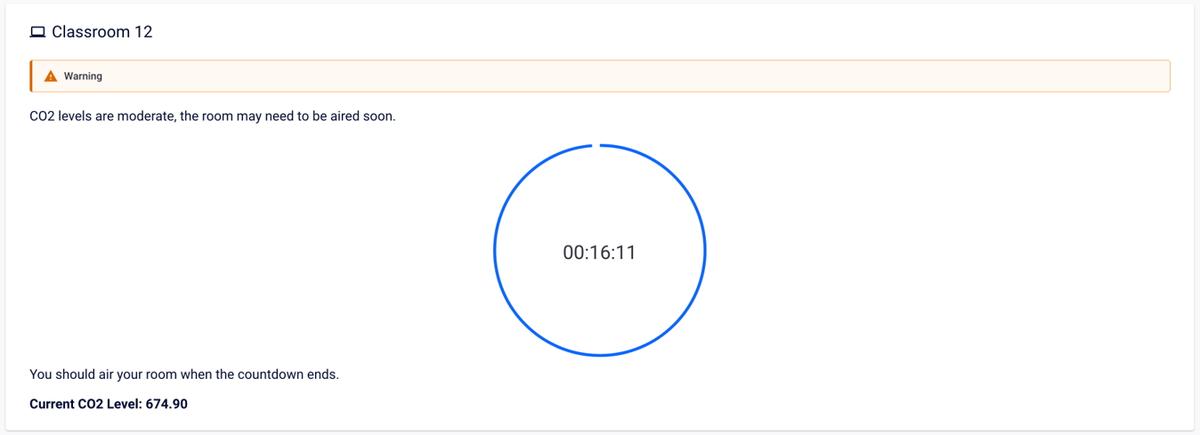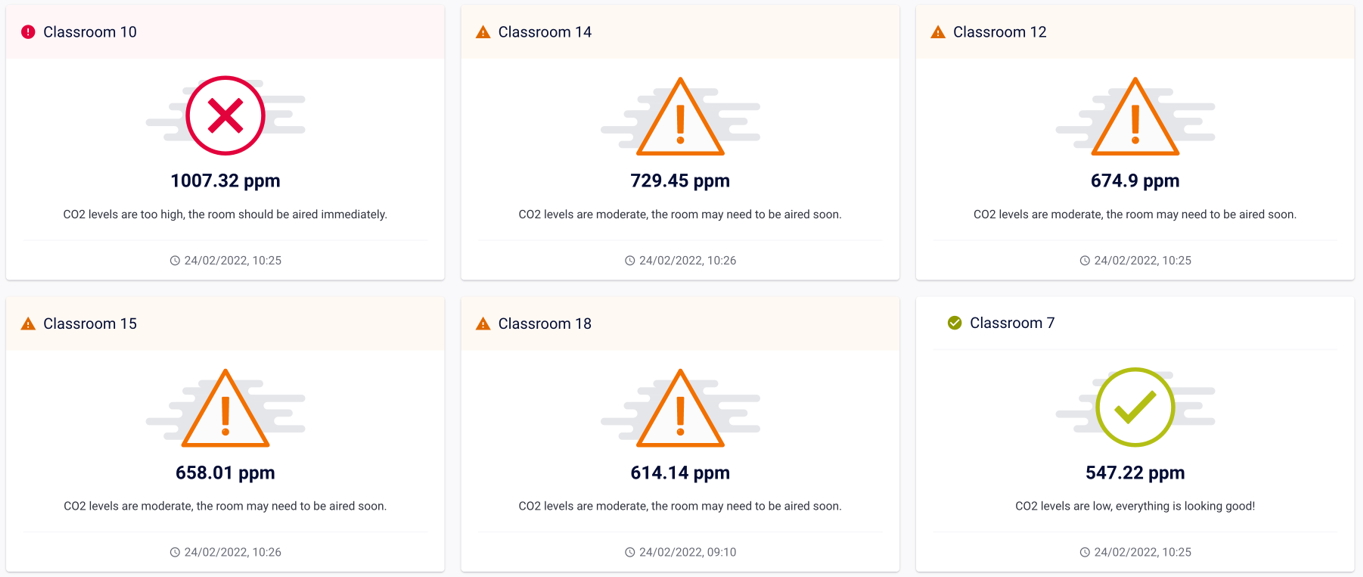IoT solutions for monitoring air quality
Keep an eye on indoor air quality and increase people’s health, general wellbeing, and productivity

How is air quality measured?
Air quality is an indicator of how clean or polluted the air is. It is measured with the Air Quality Index (AQI) that uses numbers from 0 (good air quality) to 500 (hazardous air quality that represents an emergency) to indicate the concentration of pollutants in the air at a specific site.
Pollutants are, for example:
- Carbon monoxide (CO)
- Carbon dioxide (CO₂)
- Particulate matter
- Ozone
- Volatile organic compounds (VOC)
How monitoring indoor air quality works
Our Paessler IoT solution for monitroing air quality uses IoT sensors to collect real-time indoor air quality data, for example:
- Temperature (in °C or °F)
- Humidity (in %)
- CO₂ (in ppm)
- Pressure (in hPA)
- TVOC (= total concentration of volatile organic compounds such as asbestos, for example; in ppb)
- eCO₂ (= estimated concentration of CO₂ calculated from TVOC; in ppm)
- Particulate matter (in µ/m2)
The sensors we use depend on your specific use case and what metrics you want to monitor. The collected data is sent via an LPWAN connection to our solution.
Monitoring air quality in classrooms: an example
Because regular airing is often ignored in classrooms and there are usually no mechanical ventilation systems, schools and other educational institutions were very much affected by the recent Corona pandemic.
In its guidelines for schools, the Federation of European Heating, Ventilation and Air Conditioning Associations (REHVA) recommends a limit value of 800 ppm CO₂ for indoor air before taking action becomes necessary. We know that this value is often exceeded many times over in classrooms – values of over 2,000 ppm can occur.
The measurement of CO₂ levels (or rather its equivalent eCO₂) in classrooms is therefore necessary to enhance air quality and reduce the risk of infection of COVID-19.
The air quality monitoring solution uses a simple traffic light system to signal if the CO₂ concentration in a room is okay (green), is becoming bad (orange), or is already critical (red).

Next to this visual alerting system, historical monitoring data is used to predict when a room needs to be aired. Our solution’s predictive monitoring functionality tells the teacher via a countdown how long they have until they need to air the room and how long the windows should stay open.
This way, students and teachers can not only estimate interruptions during class, but also establish an optimal airing behavior that increases their health and wellbeing and also saves heating costs in the long run.
Why is monitoring indoor air quality important?
Poor indoor air quality poses a huge health risk and directly impacts people’s wellbeing. This might not come as a surprise if you keep in mind that in a closed space, people breathe polluted air in and out more than once.
Because we exhale CO₂ with every breath, CO₂ levels are an ideal indicator of how ‘used’ the air in a room is. Degraded indoor air quality starts at 1,000 to about 1,400 ppm of CO₂ in the air.
Bad indoor air quality causes, for example:
- Physical reactions of the body such as headaches or dry throats
- Loss of concentration
- Lower productivity
- Increased absence rates because of sickness
Indoor air quality and the Corona pandemic
Indoor air quality has never been more in the spotlight than in the recent COVID-19 pandemic. Aerosols spread everywhere in a closed room within two to three minutes. This means that one single infected person is enough to infect everyone in that room, with or without a mask, with or without keeping distance.
Studies showed that the coronavirus (SARS-CoV-2) becomes inactive at high temperatures, while low humidity and very low temperatures are an ideal living environment for it. Temperatures above 20 °C, high humidity levels, and low CO₂ levels are thus ideal conditions indoors to reduce the risk of spreading the virus.
In this context, the reason why monitoring indoor air quality is particularly important becomes self-evident: only if you monitor metrics such as temperature, relative humidity, and CO₂ concentration can you take action and do something as simple as opening a window, for example.
Benefits of monitoring indoor air quality
Monitoring air quality indoors has several advantages:
- Increased health and wellbeing: people generally feel better in aired rooms as they suffer from fewer physical issues
- Better protection from infection: air quality monitoring reduces the risk of infection by viruses and other pathogens
- Increased productivity: due to the higher levels of oxygen in the air, people can concentrate better
- Reduced sick leave: there are less absence days of employees and students alike
- Reduced heating costs: effective airing and ventilation can optimize the heating behavior as well
Intrigued? We're happy to hear that!
Do you want to learn even more about our Paessler IoT solutions for air quality monitoring or do you have any questions?


